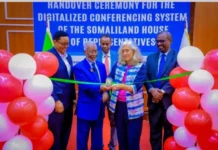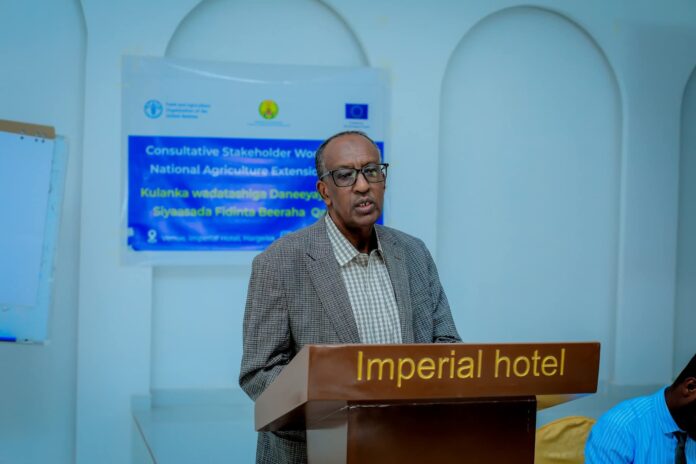Somaliland’s Agricultural Extension Policy: A Bold Blueprint for Transforming Farming and Ensuring Resilience
By [Your Name/Agency]
HARGEISA — Agriculture has long been at the heart of Somaliland’s economy, contributing 15% to the nation’s GDP and supporting the livelihoods of rural communities. However, despite its significance, the sector has faced multiple challenges: erratic rainfall, recurrent droughts, and limited access to modern agricultural knowledge. These hurdles have hindered growth, leaving farmers vulnerable and struggling to secure the nation’s food future.
In an ambitious move to address these systemic issues, the Ministry of Agriculture Development (MoAD) has released the National Agricultural Extension Policy Draft (November 23, 2025)—a bold plan that aims to revolutionize the country’s agricultural landscape. The policy envisions a shift from subsistence farming to a more sustainable, resilient, and commercially viable system, providing the necessary support to farmers in the face of climate change and growing food insecurity.
A System in Crisis: The Need for Change
For decades, agricultural extension services in Somaliland have been fragmented, underfunded, and poorly coordinated. NGOs, international development partners, and the private sector have provided much-needed support, but these efforts have often been short-term and sporadic. When external funding ended, so did the support, leaving farmers to face the challenges of unpredictable weather and low productivity without a safety net.
The policy draft identifies these weaknesses and lays bare the gap in continuity and effectiveness. “The sector is grappling with low productivity, heightened vulnerability to climate change, and a lack of knowledge transfer,” it states. The existing system has been fragmented, failing to provide consistent, sustainable support to farmers.
At the heart of the issue is the absence of a unified framework that brings together the government, NGOs, and the private sector in a coordinated effort. Agricultural extension services, meant to connect scientific research to practical farming, have been fragmented across different actors with little coordination. As a result, farmers often do not benefit from the most effective, evidence-based farming practices.
A Workshop for Change: Reviewing the National Agricultural Extension Policy
A crucial step in shaping this new policy occurred on Sunday, November 23, 2025, when a Consultative Stakeholder Workshop was held in Hargeisa. The workshop, funded by the European Union (EU) and implemented by the Ministry of Agriculture Development (MoAD) and the Food and Agriculture Organization (FAO), brought together key stakeholders from government, civil society, NGOs, farmers’ associations, the private sector, and international organizations.
Held at the Imperial Hotel in Hargeisa, the workshop served as a platform for experts and stakeholders to review the draft of the National Agricultural Extension Policy and provide critical feedback. The objective was to ensure that the policy is comprehensive, inclusive, and aligned with the realities of the agricultural sector on the ground.
During the workshop, participants discussed key issues such as the coordination between government bodies and other agricultural actors, the inclusion of marginalized groups (especially women and youth), and how digital technologies could be harnessed to improve service delivery. The feedback received will be instrumental in refining the policy as it moves toward finalization.
The New Vision: A Unified, Modernized Extension System
The National Agricultural Extension Policy aims to bridge these gaps by introducing a unified, coordinated approach to agricultural extension services. By strengthening the link between research institutions and farming communities, the policy seeks to create a more responsive, efficient, and sustainable system that can help farmers build resilience and increase productivity.
Several key innovations are central to this policy:
1. Digital Extension Services: Reaching remote, rural areas has been a persistent challenge. The policy places a heavy emphasis on Digital Extension, utilizing mobile apps, digital platforms, and community radio to provide farmers with timely and accurate information. This includes weather forecasts, pest alerts, market prices, and advice on climate-smart agricultural practices—tools that are crucial for making informed decisions in an increasingly unpredictable environment.
2. Promoting Climate-Smart Agriculture: In response to the growing threat of climate change, the policy prioritizes climate-smart agricultural practices (CSA). Extension agents will be trained to guide farmers in techniques such as soil health management, water harvesting, and the use of drought-resistant crop varieties. These practices are designed to help farmers adapt to changing conditions and protect their livelihoods against climate shocks.
3.Demand-Driven Approach: The new policy shifts away from the traditional top-down approach, embracing a demand-driven* model. This means that instead of government-imposed agricultural practices, the extension services will be tailored to meet the specific needs of farmers. Local communities will have a voice in shaping the services they receive, ensuring that the solutions provided are relevant and practical.
Empowering the Invisible Workforce
One of the most important elements of the new policy is its focus on inclusivity. It recognizes that women and youth, who make up a large part of the agricultural workforce, are often overlooked in traditional agricultural extension services. The policy explicitly aims to empower these marginalized groups by offering leadership training and creating more opportunities for their active involvement in agricultural development.
By professionalizing the extension workforce, the policy seeks to improve the delivery of services and increase the number of qualified extension agents who can support farmers. This is also an opportunity for young graduates, particularly in rural areas, to build careers in agriculture and contribute to national food security. Furthermore, by empowering women and youth, the policy aims to create a more inclusive agricultural economy that benefits all members of society.
Somaliland Vision 2030: Agriculture at the Heart of Economic Growth
The National Agricultural Extension Policy is not just a blueprint for agricultural reform; it is also a critical component of Somaliland Vision 2030, the government’s ambitious plan to achieve middle-income status by diversifying the economy. As part of this vision, the government recognizes that a thriving, resilient agricultural sector is fundamental to achieving sustainable economic growth and reducing the country’s dependence on food imports.
By integrating agricultural research, policy-making, and extension services, the new policy aims to increase local food production, reduce reliance on imported food, and enhance the competitiveness of Somaliland’s agricultural sector. The draft also lays the groundwork for a more resilient agricultural value chain—one that can withstand climate shocks, improve food security, and create new economic opportunities.
A Bright Future for Somaliland’s Farmers
As the policy draft moves closer to finalization, it is clear that the government is committed to long-term agricultural transformation. For the first time, Somaliland has a comprehensive strategy that provides a clear path forward for sustainable agricultural development.
For the farmers who have long struggled with the uncertainties of climate change, limited resources, and inadequate support, the National Agricultural Extension Policy offers hope. Through digital innovation, climate-smart practices, and a more inclusive and responsive extension system, Somaliland’s agricultural future looks brighter than ever before.
With the right investments and a coordinated approach, Somaliland can transition from a country dependent on unpredictable weather patterns to a thriving agricultural economy capable of meeting the food security needs of its population—and beyond.







































